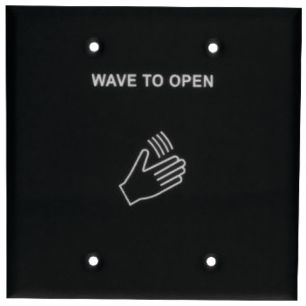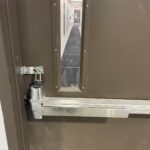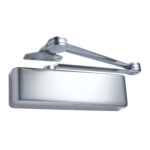 With the current focus on how to limit the spread of germs, many facility managers are considering the addition of automatic operators so doors can be operated “hands-free.” I’ve been receiving lots of questions about touchless switches, remote transmitters, and codes related to auto operators in general.
With the current focus on how to limit the spread of germs, many facility managers are considering the addition of automatic operators so doors can be operated “hands-free.” I’ve been receiving lots of questions about touchless switches, remote transmitters, and codes related to auto operators in general.
I’ve compiled the list below to help summarize the requirements, with links to longer articles and more information.
~~~
Referenced Codes and Standards: The codes and standards listed here include requirements related to automatic operators and are referenced in some of the summaries and articles below. If you are an Allegion employee, these documents can be downloaded from our Techstreet subscription (contact me if you need help). The ADA standards can be downloaded from ADA.gov.
- BHMA A156.19 – Power Assist & Low Energy Power Operated Doors
- BHMA A156.10 – Power Operated Pedestrian Doors
- ADA Standards for Accessible Design
- ICC A117.1 – Accessible and Usable Buildings and Facilities
- International Building Code (IBC)
- NFPA 101 – Life Safety Code
- NFPA 80 – Standard for Fire Doors and Other Opening Protectives
Summaries and Links: The following summaries address requirements pertaining to automatic doors. Each heading title is a link to more information.
- Public Entrances: Changes have been approved for the 2021 IBC that will require automatic operators at some public entrances. Currently, the codes and standards do not mandate auto operators, although they are sometimes installed to overcome a code issue such as limited maneuvering clearance, or opening force that exceeds the maximum allowed by code.
- Stand-By Power: Doors with automatic operators are not subject to the same maneuvering-clearance requirements as manually-operated doors. However, if a door does not have the required clearance on the egress side, and an automatic operator is added to bring the door into compliance, the automatic operator must have stand-by power so it will function in an emergency. Automatic operators on fire-rated doors are required to be deactivated upon fire alarm. Therefore, an automatic operator with standby power should not be used on a fire door to overcome maneuvering clearance problems because the operator will not be functional when the fire alarm is sounding.
- Actuators: In order to comply with BHMA A156.19, low-energy operators must be initiated by a “knowing act.” The knowing-act method may be a push plate actuator or non-contact switch mounted on the wall or jamb, the act of manually pushing or pulling a door, a wireless transmitter, or an access control device like a card reader, keypad, or keyswitch. The standard includes recommended locations for actuators.
- Touchless Switches: Actuators that can be operated by the wave of a hand are considered a knowing act by A156.19, but the detection range (the distance from the waving hand to the switch) should be no more than 12 inches.
- Monitored Sensors: A change was made to the 2017 edition of BHMA A156.10, which requires safety sensors to be monitored. If the safety sensor is not functioning, the door is not supposed to open. Although this standard does not usually apply to low-energy operators, it does apply to low-energy operators that are not initiated by a knowing act. A low-energy operator that is actuated by a motion sensor must comply with A156.10, including the use of guide rails and safety sensors, and these sensors must be monitored according to the 2017 change.
- Timing: The BHMA standards include minimum times for the opening and closing cycles, as well as a minimum hold-open time. For low-energy operators there is a table in the standard which states these minimums based on the door width, door weight, and actuator position.
- Power-Assist: Although some people call doors with low-energy operators “power-assist” doors, they are two different types of operators and the requirements of the codes and standards vary. A power-assist door has an operator that reduces the opening force but requires the door to be opened manually. A low-energy operator opens the door automatically.
- Signage: The BHMA standards include requirements for signage, which vary for low-energy operators depending on how the door is actuated. Every automatic door is required to have the mandated signage installed.
If there are other topics that I should add, just leave a comment below.
You need to login or register to bookmark/favorite this content.





What determines if a low energy operator is required?
What does the weight of door have to do with ADA opening force?
Hi Kat –
Examples would be if the door could not be opened manually with 5 pounds of force (assuming an interior non-fire-rated door), or if there was not enough maneuvering clearance, adding an automatic operator could bring the door into compliance with the accessibility requirements.
– Lori
This is excellent news and info
Thank you Lori
Thanks for informing me that the 2017 edition of BHMA requires monitoring for safety sensors since the automatic doors would not open if the sensor is not functioning. One of the automatic doors in my office has not been working for two days now, and it’s a major inconvenience since we have handicapped employees. I’ll try to ask my boss later if they had the sensors monitored the past years, and if he wants me to contact an automatic door repair service soon so it can be fixed.
Doors with automatic operators are not subject to the same maneuvering-clearance requirements as manually-operated doors. – Where is this in the code?
Hi Mike –
If you look at the ADA Standards or A117.1, the requirements for manual and automatic doors are different. For example, in the ADA standards, the maneuvering clearance requirements for manual doors are in Table 404.2.4.1 – Maneuvering Clearances at Manual Swinging Doors and Gates. In the automatic door section it says:
404.3.2 Maneuvering Clearance. Clearances at power-assisted doors and gates shall comply with 404.2.4. Clearances at automatic doors and gates without standby power and serving an accessible means of egress shall comply with 404.2.4.
EXCEPTION: Where automatic doors and gates remain open in the power-off condition, compliance with 404.2.4 shall not be required.
Power-assisted doors and gates are not automatic doors – a power-assist operated reduces the opening force but the doors still have to be opened manually. So those doors are required to comply with the maneuvering clearance requirements for manual doors. Automatic doors are not required to comply with 404.2.4 – the exception is when the door doesn’t have the required maneuvering clearance on the egress side – in that case the auto operator would need standby power.
Let me know if you have a different interpretation.
– Lori
Hi Lori,
If a power operated door uses sensor release and also has a push to exit button, would or could that be considered Sensor Relase of electrically locked egress doors 1010.1.9.8 and need to comply with those requirements as well as 1010.1.4.2 or are the requirements in 1010.1.4.2 adequate to manage those release devices? Thanks!
Thank you for letting me know that the 2017 version of the BHMA requires safety sensor monitoring because if the sensor isn’t working, the automated doors won’t open. It’s been two days since one of the automated doors in my workplace stopped working, which is a huge nuisance given that we have staff who are disabled. Later, I’ll attempt to ask my employer whether the sensors have been checked recently and whether he wants me to get in touch with an automatic door repair agency right away to get it serviced.